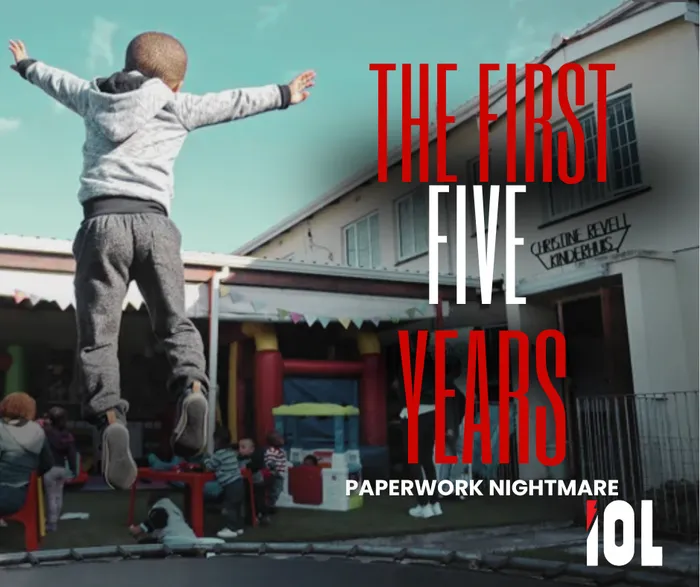The First Five Years | Paperwork nightmare traps SA’s poorest children in poverty

The 2021 ECD Census in South Africa highlights a severe cycle of poverty and bureaucratic red tape, with only 40% of Early Learning Programmes fully registered and 33% receiving government subsidies, leaving millions of children without access to quality early childhood development services.
Image: Tracey Adams/African News Agency (ANA)
Like the young children it caters for, the Early Childhood Development (ECD) census is still in its infancy, and though the data at this stage is limited, it already revealed a harrowing picture— there is a vicious cycle of red tape that is handicapping the poor in South Africa from ever competing on a level playing field.
Experts say the first five years of a child’s life lay the foundation for all future learning, health, and productivity, yet this critical stage remains one of the most neglected areas in South Africa’s education system.
The first ECD Census in South Africa was carried out in 2021, which was a ‘complete mapping of ECD services’ in the country.
The aim was to identify gaps in access to quality Early Learning Programmes (ELPs) and how that affects the development of children in the education system.
Though the situation is far from ideal in both rural and urban areas, there is a stark contrast between the two.
Overcoming Red Tape: The Challenge of ECD Centre Registration and Subsidy Access in South Africa
The main stumbling point? Red tape and municipal compliance issues that keep the poorest in the country effectively shut out. ECD centre registration requires seven approvals, including zoning, building plans, and health certificates.
Delays in municipal departments, especially in poorer areas, hinder registration and subsidies. According to the ECD Census, there are 42,420 ELPs across South Africa, enrolling 1,660,316 children.
Of these, only 40% are fully or conditionally registered with the Department of Social Development (DSD); another 16% are in the process of registering; the remaining 42% remain unregistered. To further illustrate the inequality, roughly a third (33%) receive government subsidies.
It means that tens of thousands of centres, mostly in rural and informal settlements, are left out in the cold with no access to subsidies and hordes of children from poor backgrounds doomed to a cycle of poverty.
Challenges for ECD Centres in Informal and Rural Areas
Navigating the maze of paperwork and guidelines to receive subsidies can be completely overwhelming. The municipal requirements alone mean ECD centres have to meet a number of requirements, including: land-use zoning, fire-safety compliance, sanitation and environmental health certification, structural standards, and sufficient space for children.
There’s little to no chance ECD centres in informal and rural areas can meet many of these requirements, and it’s quite shocking that something like access to running water is still a stumbling block in South Africa in 2025. Pit toilets still are a major concern, with flushing toilets being a bare necessity which simply cannot be met by 40% of ECD centres.
Challenges in ECD Centre Infrastructure: A Catch-22 Situation
The infrastructure outside of urban areas is simply not there, and without outside assistance, little progress can be made. It’s, of course, a catch-22 situation; in order to receive government assistance, these ECD centres need to have certain infrastructure in place, but without any outside aid, this is nothing but a pipe dream.
Therefore, it means the unregistered ECD centres will usually be critically understaffed and only able to cater for a maximum of 25 children. A staggering 75% of unregistered centres don’t have access to a bank account, which makes future compliance impossible.
ECD Registration Challenges in Urban and Rural Areas
Even in urban areas, however, the situation could be similar. According to forgood.org.za, in 2023, 58% of Cape Town’s ECDs are unregistered.
Still, the fact remains that in more established, formally zoned areas – often in urban suburbs – ECD centres can more reliably tick the compliance boxes: land titles, municipal services, fire/electrical certificates are more easily obtained.
An ECD centre in a rural area is more likely to be running from family-owned land with no formal zoning certificates, which are often held in converted houses or churches. This means there’s unlikely to be a kitchen, and, again, sanitation compliance is unattainable.
The 2021 ECD Census reveals high poverty rates for young children in Limpopo, KwaZulu-Natal, and the Eastern Cape. While many centres in these provinces receive DSD subsidies, a higher proportion of centres in the Free State also receive these subsidies.
Electrification and Sanitation Levels Stagnant Since 2013: Gauteng Leads in ELPs but Faces Low Subsidy Claims
Electrification and sanitation levels remained largely unchanged from earlier audits. The last national facilities audit prior to the 2021 Census, the 2013 audit showed 83% had electricity for lighting, 53% for cooking, and 80% had piped water.
This means there has been no improvement in almost a decade.
Overall, Gauteng has the most ELPs with 10,376, with over 400,000 children registered. However, it is still among the lowest proportion of fully registered ELPs. In fact, Gauteng has around just 15% of ELPs claiming a subsidy, while the Free State has the most with 57%.
Northern Cape has the most fully registered ELPs with 43%.
The facts are disheartening.
There are an estimated four million children in South Africa who remain outside any kind of ELP, not because the centres don’t exist but because those institutions cannot jump through the myriad of bureaucratic hoops.
The system for registration needs to be streamlined, and until that happens, the cycle will carry on for generations to come.
Related Topics: